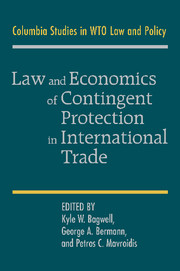Book contents
- Frontmatter
- Contents
- Contributors
- Introduction
- 1 An Overview of the Agreement on Subsidies and Countervailing Measures – Including a Discussion of the Agreement on Agriculture
- 2 Do the World Trade Organization Disciplines on Domestic Subsidies Make Sense? The Case for Legalizing Some Subsidies
- 3 Subsidies and Countervailing Measures: Determining the Benefit of Subsidies
- 4 The Enduring Problem of World Trade Organization Export Subsidies Rules
- 5 The Boeing–Airbus Dispute: A Case for the Application of the European Community State Aid Rules?
- 6 Antidumping: Overview of the Agreement
- 7 Price Differentiation in Antitrust and Trade Instruments
- 8 Nonpreferential Origin Rules in Antidumping Law and Practice
- 9 The Appellate Body Interpretation of “Sunset Reviews” Provisions of Anti-Dumping and Countervailing Measures Agreements: A Critical Analysis
- 10 The Safeguards Agreement – An Overview
- 11 Why Are Safeguards Needed in a Trade Agreement?
- Index
- References
8 - Nonpreferential Origin Rules in Antidumping Law and Practice
Published online by Cambridge University Press: 03 May 2010
- Frontmatter
- Contents
- Contributors
- Introduction
- 1 An Overview of the Agreement on Subsidies and Countervailing Measures – Including a Discussion of the Agreement on Agriculture
- 2 Do the World Trade Organization Disciplines on Domestic Subsidies Make Sense? The Case for Legalizing Some Subsidies
- 3 Subsidies and Countervailing Measures: Determining the Benefit of Subsidies
- 4 The Enduring Problem of World Trade Organization Export Subsidies Rules
- 5 The Boeing–Airbus Dispute: A Case for the Application of the European Community State Aid Rules?
- 6 Antidumping: Overview of the Agreement
- 7 Price Differentiation in Antitrust and Trade Instruments
- 8 Nonpreferential Origin Rules in Antidumping Law and Practice
- 9 The Appellate Body Interpretation of “Sunset Reviews” Provisions of Anti-Dumping and Countervailing Measures Agreements: A Critical Analysis
- 10 The Safeguards Agreement – An Overview
- 11 Why Are Safeguards Needed in a Trade Agreement?
- Index
- References
Summary
Introduction
This article first examines the efforts made at a multilateral level to establish disciplines on rules of origin and the various techniques that may be used in drafting rules of origin. The second part discusses the role of origin rules in antidumping law and practice, with a focus on the European Union (EU) system. It analyzes the use of such rules as an operative tool during the investigative process and as an enforcement mechanism when antidumping measures are imposed. It concludes with an overview on the status of the Harmonization Work Programme (HWP) under the World Trade Organization (WTO) Agreement on Rules of Origin (ARO) and the recent proposals on anticircumvention made in the negotiating group on rules.
Although the use of harmonized nonpreferential origin rules in the context of antidumping proceedings remains a desirable goal, it should realistically go hand in hand with the establishment of third-country anticircumvention legislation.
Nonpreferential Rule of Origin and Methodologies for Drafting Rules of Origin
Efforts to Establish Multilateral Rules and Methodologies Used
The issue of rules of origin (as opposed to origin markings, to which Article IX of the General Agreement on Tariffs and Trade [GATT] is devoted, because of U.S. influence) did not attract much attention in the negotiation of the original GATT. On the contrary, during the second session of the Preparatory Committee in 1947, a subcommittee considered that “it is to be clear that it is within the province of each importing member to determine, in accordance with the provisions of its law, for the purpose of applying the most-favoured-nation (MFN) provision whether goods do in fact originate in a particular country.”
- Type
- Chapter
- Information
- Publisher: Cambridge University PressPrint publication year: 2009
References
- 5
- Cited by



